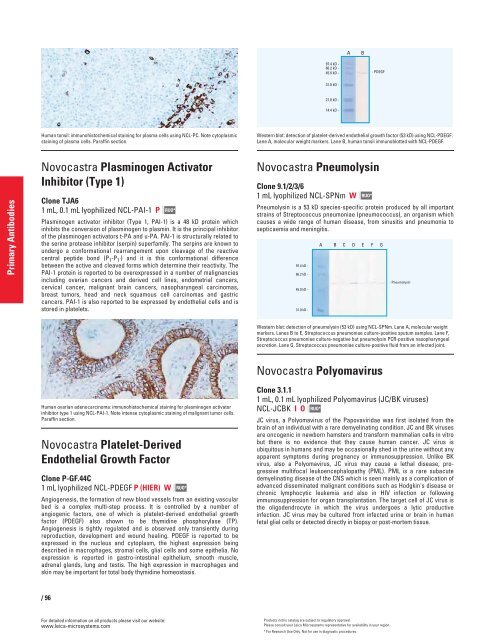QF0159 Marketing Release Record
QF0159 Marketing Release Record
QF0159 Marketing Release Record
Create successful ePaper yourself
Turn your PDF publications into a flip-book with our unique Google optimized e-Paper software.
Primary Antibodies<br />
Human tonsil: immunohistochemical staining for plasma cells using NCL-PC. Note cytoplasmic<br />
staining of plasma cells. Paraffin section.<br />
Novocastra Plasminogen Activator<br />
Inhibitor (Type 1)<br />
Clone TJA6<br />
1 mL, 0.1 mL lyophilized NCL-PAI-1 P<br />
Plasminogen activator inhibitor (Type 1, PAI-1) is a 48 kD protein which<br />
inhibits the conversion of plasminogen to plasmin. It is the principal inhibitor<br />
of the plasminogen activators t-PA and u-PA. PAI-1 is structurally related to<br />
the serine protease inhibitor (serpin) superfamily. The serpins are known to<br />
undergo a conformational rearrangement upon cleavage of the reactive<br />
central peptide bond (P 1 -P 1' ) and it is this conformational difference<br />
between the active and cleaved forms which determine their reactivity. The<br />
PAI-1 protein is reported to be overexpressed in a number of malignancies<br />
including ovarian cancers and derived cell lines, endometrial cancers,<br />
cervical cancer, malignant brain cancers, nasopharyngeal carcinomas,<br />
breast tumors, head and neck squamous cell carcinomas and gastric<br />
cancers. PAI-1 is also reported to be expressed by endothelial cells and is<br />
stored in platelets.<br />
Human ovarian adenocarcinoma: immunohistochemical staining for plasminogen activator<br />
inhibitor type 1 using NCL-PAI-1. Note intense cytoplasmic staining of malignant tumor cells.<br />
Paraffin section.<br />
Novocastra Platelet-Derived<br />
Endothelial Growth Factor<br />
Clone P-GF.44C<br />
1 mL lyophilized NCL-PDEGF P (HIER) W<br />
Angiogenesis, the formation of new blood vessels from an existing vascular<br />
bed is a complex multi-step process. It is controlled by a number of<br />
angiogenic factors, one of which is platelet-derived endothelial growth<br />
factor (PDEGF) also shown to be thymidine phosphorylase (TP).<br />
Angiogenesis is tightly regulated and is observed only transiently during<br />
reproduction, development and wound healing. PDEGF is reported to be<br />
expressed in the nucleus and cytoplasm, the highest expression being<br />
described in macrophages, stromal cells, glial cells and some epithelia. No<br />
expression is reported in gastro-intestinal epithelium, smooth muscle,<br />
adrenal glands, lung and testis. The high expression in macrophages and<br />
skin may be important for total body thymidine homeostasis.<br />
/96<br />
For detailed information on all products please visit our website:<br />
www.leica-microsystems.com<br />
RUO*<br />
RUO*<br />
Western blot: detection of platelet-derived endothelial growth factor (53 kD) using NCL-PDEGF.<br />
Lane A, molecular weight markers. Lane B, human tonsil immunoblotted with NCL-PDEGF.<br />
Novocastra Pneumolysin<br />
Clone 9.1/2/3/6<br />
1 mL lyophilized NCL-SPNm W<br />
RUO*<br />
Pneumolysin is a 53 kD species-specific protein produced by all important<br />
strains of Streptococcus pneumoniae (pneumococcus), an organism which<br />
causes a wide range of human disease, from sinusitis and pneumonia to<br />
septicaemia and meningitis.<br />
Western blot: detection of pneumolysin (53 kD) using NCL-SPNm. Lane A, molecular weight<br />
markers. Lanes B to E, Streptococcus pneumoniae culture-positive sputum samples. Lane F,<br />
Streptococcus pneumoniae culture-negative but pneumolysin PCR-positive nasopharyngeal<br />
secretion. Lane G, Streptococcus pneumoniae culture-positive fluid from an infected joint.<br />
Novocastra Polyomavirus<br />
Clone 3.1.1<br />
1 mL, 0.1 mL lyophilized Polyomavirus (JC/BK viruses)<br />
NCL-JCBK IO RUO*<br />
JC virus, a Polyomavirus of the Papovaviridae was first isolated from the<br />
brain of an individual with a rare demyelinating condition. JC and BK viruses<br />
are oncogenic in newborn hamsters and transform mammalian cells in vitro<br />
but there is no evidence that they cause human cancer. JC virus is<br />
ubiquitous in humans and may be occasionally shed in the urine without any<br />
apparent symptoms during pregnancy or immunosuppression. Unlike BK<br />
virus, also a Polyomavirus, JC virus may cause a lethal disease, progressive<br />
multifocal leukoencephalopathy (PML). PML is a rare subacute<br />
demyelinating disease of the CNS which is seen mainly as a complication of<br />
advanced disseminated malignant conditions such as Hodgkin's disease or<br />
chronic lymphocytic leukemia and also in HIV infection or following<br />
immunosuppression for organ transplantation. The target cell of JC virus is<br />
the oligodendrocyte in which the virus undergoes a lytic productive<br />
infection. JC virus may be cultured from infected urine or brain in human<br />
fetal glial cells or detected directly in biopsy or post-mortem tissue.<br />
Products in this catalog are subject to regulatory approval.<br />
Please consult your Leica Microsystems representative for availability in your region.<br />
* For Research Use Only. Not for use in diagnostic procedures.
















